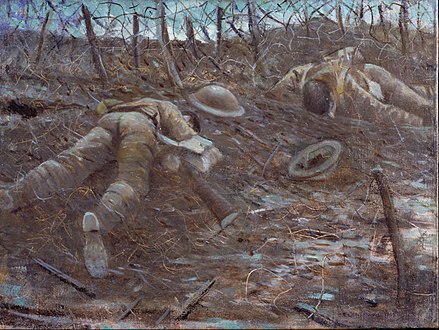Imperial War Museum
Imperial War Museums | |
|
The Imperial War Museum (IWM), currently branded "Imperial War Museums", is a British
Originally housed in
The museum's collections include
The museum is funded by government grants, charitable donations, and revenue generation through commercial activity such as retailing, licensing, and publishing. General admission is free to IWM London (although specific exhibitions require the purchase of a ticket) and IWM North, but an admission fee is levied at the other branches. The museum is an
History of the museum
Establishment: 1917–1924
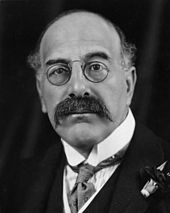
On 27 February 1917 Sir Alfred Mond, a Liberal MP and First Commissioner of Works, wrote to the Prime Minister David Lloyd George to propose the establishment of a National War Museum. This proposal was accepted by the War Cabinet on 5 March 1917 and the decision announced in The Times on 26 March. A committee was established, chaired by Mond, to oversee the collection of material to be exhibited in the new museum.[5][6]
This National War Museum Committee set about collecting material to illustrate Britain's war effort by dividing into subcommittees examining such subjects as the Army, the Navy, the production of
| Imperial War Museum Act 1920 | |
|---|---|
| Act of Parliament | |
 10 & 11 Geo. 5. c. 16 | |
| Dates | |
| Royal assent | 2 July 1920 |
| Text of statute as originally enacted | |
| Text of the Imperial War Museum Act 1920 as in force today (including any amendments) within the United Kingdom, from legislation.gov.uk. | |
The museum was opened by King George V at the Crystal Palace on 9 June 1920. During the opening ceremony, Sir Alfred Mond addressed the King on behalf of the committee, saying that "it was hoped to make the museum so complete that every one who took part in the war, however obscurely, would find therein an example or illustration of the sacrifice he or she made" and that the museum "was not a monument of military glory, but a record of toil and sacrifice".[12] Shortly afterwards the Imperial War Museum Act 1920 was passed and established a board of trustees to oversee the governance of the museum. To reflect the museum's Imperial remit the board included appointees of the governments of India, South Africa, Canada, Australia and New Zealand.[13] While the Act was being debated, some Parliamentarians felt that the museum would perpetuate an undesirable war spirit and Lieutenant-Commander Joseph Kenworthy MP said that he would "refuse to vote a penny of public money to commemorate such suicidal madness of civilisation as that which was shown in the late War".[14] On the August Bank Holiday 1920, the first public holiday since the museum's opening, 94,179 visitors were received,[15] and by November 1921, 2,290,719 had visited the museum.[16]
Relocation 1924–1936

| Bethlem Hospital (Amendment) Act 1931 | ||
|---|---|---|
| Act of Parliament | ||
 Commencement 31 July 1931 | | |
Status: Current legislation | ||
| Text of statute as originally enacted | ||
In 1924 the museum moved to the
The two extensive wings were removed and the resulting space named
Second World War and after: 1939–1966
With the outbreak of the
In October 1945 the museum mounted a temporary exhibition, the first since the end of the war in August, which showcased technologies developed by the
Redevelopment and expansion: 1966–2012

In 1966 the museum's Southwark building was extended to provide collections storage and other facilities, the first major expansion since the museum had moved to the site. The development also included a purpose-built cinema.[31] In 1967 the museum acquired a pair of 15-inch naval guns. One had been mounted on the Royal Navy's HMS Ramillies and the other on both HMS Resolution and HMS Roberts. Both had been fired in action during the Second World War. They went on permanent display outside the museum in May 1968.[32] The acquisition of these guns, representative of the dreadnought era of British battleships, led the museum to seek to acquire a 6-inch triple turret that would be representative of a number of classes of British cruisers.[33] This would eventually lead to the preservation of the Royal Navy light cruiser HMS Belfast, which became a branch of the museum in 1978.[34] Later in 1968 on 13 October the museum was attacked by an

In 1969 RAF Duxford, a
By 1983 the museum was again looking to redevelop the Southwark site and approached engineering firm
The first phase of the works to the Southwark building started in 1986 and were completed in 1989, during which time the museum was closed to the public. The work included the conversion of what was previously the hospital's courtyard into a centrepiece Large Exhibits Gallery. This gallery featured a strengthened ground floor (to support the weight of very heavy exhibits), a first floor
In September 1992 the museum was the target of a Provisional Irish Republican Army attack against London tourist attractions. Two incendiary devices were found in a basement gallery, but were extinguished by staff before the arrival of the fire brigade, and caused only minor damage.[45][46]
The second stage of the redevelopment of the Southwark building, during which the museum remained open to the public, was completed in 1994.
The following year, 2000, the final phase of the Southwark redevelopment was completed. The development included the installation of the museum's Holocaust Exhibition which was opened by the Queen on 6 June 2000. This was the first permanent exhibition dedicated to the
Between 2004 and 2010 the museum was a partner in a national learning project entitled "Their Past Your Future" (TPYF), part of the
In October 2011 the museum rebranded itself as Imperial War Museums, the initials IWM forming the basis of a new corporate logo.[55]
In September 2011 the museum secured funding from
First World War centenary: 2014
In August 2009 the museum announced the creation of the Imperial War Museum Foundation. Chaired by
IWM London was formally reopened on 17 July 2014 by
Branches
From the 1970s onwards the Imperial War Museum began to expand onto other sites. The first branch,
Imperial War Museum London
Architecture and layout
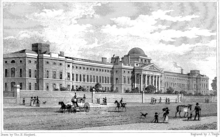
The museum has occupied the former Bethlem Royal Hospital on Lambeth Road since 1936. The hospital building was designed by the hospital surveyor, James Lewis, from plans submitted by John Gandy and other architects, and construction completed in October 1814. The hospital consisted of a range of buildings 580 feet long with a basement and three storeys, parallel to Lambeth Road, with a central entrance under a portico.[71]

The building was substantially altered in 1835 by architect Sydney Smirke. In order to provide more space, he added blocks at either end of the frontage, and galleried wings on either side of the central portion. He also added a small single-storey lodge, still in existence, at the Lambeth Road gate. Later, between 1844 and 1846, the central cupola was replaced with a copper-clad dome in order to expand the chapel beneath. The building also featured a theatre in a building to the rear of the site.[71]
The building remained substantially unchanged until vacated by the hospital in 1930. After the
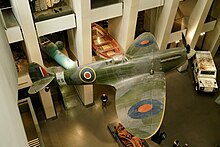
The original hospital building is now largely occupied by corporate offices. The 1966 extension houses the library, art store, and document archives while the 1980s redevelopments created exhibition space over five floors. The first stage created 8,000 m2 of gallery space of which 4,600 m2 was new, and the second provided a further 1,600 m2.
In August 2019, the museum announced plans to spend over £30m on a new set of galleries over two floors at its London site covering the Holocaust and its importance in World War II.[78] The galleries opened in October 2021 to replace the existing permanent exhibition.[79]
All Saints Annexe
In 1989 the museum acquired the All Saints Annexe, a former hospital building in Austral Street off
Imperial War Museum Duxford
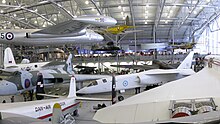
Imperial War Museum Duxford, near the village of Duxford in Cambridgeshire, is Britain's largest aviation museum.[82] Duxford houses the museum's large exhibits, including nearly 200 aircraft, military vehicles, artillery and minor naval vessels in seven main exhibitions buildings.[83] The site also provides storage space for the museum's collections of film, photographs, documents, books and artefacts. The site accommodates a number of British Army regimental museums, including those of the Parachute Regiment and the Royal Anglian Regiment.
Based on the historic
HMS Belfast (1938)
In 2017, the name of the exhibit was changed to "HMS Belfast 1938" to reflect that one of the Royal Navy's new Type 26 frigates had been given the name HMS Belfast.[87]
Churchill War Rooms
The Cabinet War Rooms is an underground complex that served as a British government command centre throughout the Second World War. Located beneath the
Imperial War Museum North

The Imperial War Museum North was opened in
The museum's first floor main gallery space houses the permanent exhibitions. These consist of a chronological display which runs around the gallery's 200m perimeter and six thematic displays in "silos" within the space. The walls of the gallery space are used as screens for the projection of an hourly audiovisual presentation, the Big Picture. The main gallery, described as cavernous and dramatic,
Collections

The Imperial War Museum's original collections date back to the material amassed by the National War Museum Committee. The present departmental organisation came into being during the 1960s as part of Frankland's reorganisation of the museum. The 1970s saw oral history gain increasing prominence and in 1972 the museum created the Department of Sound Records (now the Sound Archive) to record interviews with individuals who had experienced the First World War. The museum maintains an online database of its collections.[101]
Documents
The museum's documents archive seeks to collect and preserve the private papers of individuals who have experienced modern warfare. The archive's holdings range from the papers of senior British and Commonwealth army, navy and air officers, to the letters, diaries and memoirs of lower-ranked servicemen and of civilians. The collection includes the papers of Field Marshals
Art
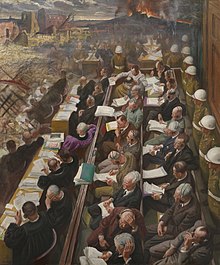
The museum's art collection includes paintings, prints, drawings, sculpture, and works in film, photography and
In 1972 the museum established the Artistic Records Committee (since renamed the Art Commissions Committee) to commission artists to cover contemporary conflicts.
Film

The museum's Film and Video Archive is one of the oldest
The archive also holds government information films and propaganda features such as
Photographs
The museum's Photograph Archive preserves photographs by official, amateur and professional photographers. The collection includes the official British photographic record of the two world wars; the First World War collection includes the work of photographers such as Ernest Brooks and John Warwick Brooke.[126][127] The archive also holds 150,000 British aerial photographs from the First World War,[128] the largest collection of its kind.[129] The Second World War collection includes the work of photographers such as Bill Brandt, Cecil Beaton[130] and Bert Hardy.[131] Like the Film Archive, the Photograph Archive is an official repository under the 1958 Public Records Act, and as such continues to receive material from the Ministry of Defence. In 2012 the museum reported the size of its photographic holdings as approximately 11 million images in 17,263 collections.[105]
Exhibits
The museum's exhibits collection includes a wide range of objects, organised into numerous smaller collections such as uniforms, badges, insignia and flags (including a
The ordnance collection includes artillery pieces that participated in notable battles, such as the Néry gun, a field gun that was used during the 1914
Library
The museum's library is a national reference collection on modern conflict, and holds works on all aspects of warfare, including regimental or unit histories (such as 789 rare German unit histories from the First World War),
Sound
The museum's Sound Archive holds 33,000 sound recordings, including a large collection of oral history recordings of witnesses to conflicts since 1914.[149] The museum's sound collection originated in 1972 with the creation of the Department of Sound Records and the instigation of an oral history recording programme. The sound collection opened to the public in July 1977.[150] The collection also includes recordings made by the BBC during the Second World War, actuality sound effects, broadcasts, speeches and poetry. As part of the museum's First World War centenary programme, the museum is producing Voices of the First World War, a podcast series drawing upon the museum's oral history recordings.[151] In 2012 the museum reported the size of its sound collection as 37,000 hours.[105]
Databases
The IWM has an online database, listing the various items which make up the IWM Collections. In some cases, there are images of the item, or contemporary photos, which can be shared and reused under a Creative Commons Licence.
The War Memorials Register is a database of known war memorials in the United Kingdom. Information such as the material used in construction, the condition of the memorial, its address and coordinates with a satellite map plot are recorded for each of the memorials. Whilst many memorials commemorate those who died in the First World War,[152] the scope of the project is all conflicts. As of 2022[update], there are over 90,000 memorials on the register.[153]
In 2014, IWM and online genealogy service provider Findmypast entered into a collaboration to launch the "Lives of the First World War" platform.[citation needed] During the centenary period, anyone could sign up for an account, and those who paid for a subscription had the ability to add records from Findmypast's collections.[154]
A number of sources (War Office medal index cards, Canadian Expeditionary Force attestations, Royal Navy service records etc.) had been used as seeding documents to create individual entries in the database. Each person's profile in the database could have been further built up, so as to document when that person was born, when they died, family members etc. If a person needed to be added, or a duplicate existed that needed to be merged, such activity was requested via a support forum manned by IWM volunteers. A user with a subscription had the ability to group person profiles together into a "community". This could be a grouping based around a ship's crew, a unit in the army, or the names of men and women buried in a given war cemetery.[155]
The goal was to encourage crowdsourcing to build up as many details as possible in the database, and to tap into the popularity of online genealogy as a pastime. One selling point of the platform was that the data thus captured would form a "permanent digital memorial[156] [that] will be saved for future generations."[157] The IWM declared that the data from the platform would become part of its archive when the platform ceased to be interactive in 2019, "and will be free to access online for research."[158]
Size of collection
The museum holds around a half of
Selected collection highlights
-
John Singer Sargent
-
Nash, Paul
-
Nevinson, C R W
-
Tonks, Henry
Governance
The Imperial War Museum is an executive
The museum's director-general is answerable to the trustees and acts as accounting officer. Since 1917 the museum has had six directors. The first was
Arms
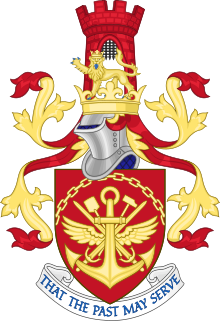
|
|
References
- ^ "ALVA - Association of Leading Visitor Attractions". www.alva.org.uk. Retrieved 23 October 2020.
- ^ Whitmore, Mark (letter to Frankie Roberto) (12 May 2008) WhatDoTheyKnow.com Total number of objects in the Imperial War Museum's collection. Retrieved 28 October 2009.
- ^ Imperial War Museums. "About us". iwm.org.uk. Retrieved 28 August 2012.
- ^ "Our Executive Leadership Team".
- S2CID 159747045.
- ^ 'National War Museum. The Collection of Relics And Souvenirs', The Times, 26 March 1917 Issue 41436, page 5 column C
- ^ Kavanagh 1988 p.82
- ^ Kavanagh 1988 p.83
- ^ James Mann, 'ffoulkes, Charles John (1868–1947)’, rev. William Reid, Oxford Dictionary of National Biography, Oxford University Press, 2004; online edn, Oct 2006 accessed 22 June 2009
- ^ 'The War Museum. Sir Alfred Mond's visit to the front', The Times, 24 July 1917, Issue 41538, page 3 column C
- ISBN 0-7185-1713-X. Retrieved 30 January 2012.
- ^ 'The Greatest War Memorial. Opening by the King. Human Interest at the Crystal Palace'. The Times, 10 June 1920, Issue 42433, page 11 column D
- ^ a b Office of Public Sector Information Revised Statute from The UK Statute Law Database: Imperial War Museum Act 1920 (c.16). Retrieved 14 April 2010.
- ^ Hansard, 12 April 1920 Imperial War Museum Bill HC Deb 12 April 1920 vol 127 cc1465-9 Hansard 1803–2005 Accessed 22 March 2009.
- ^ Their Past Your Future. "Learning Resources for Teaching History – Key Stages 3 and 4 – The Imperial War Museum" (PDF). Imperial War Museum. Archived from the original (PDF) on 19 July 2011. Retrieved 18 March 2011.
- ^ 'Public And Crystal Palace. Full Benefit Later', The Times, 15 November 1921, Issue 42878, page 5 column D
- ^ 'The Imperial War Museum: Lack of Accommodation',The Times 25 August 1933 Issue 46532, page 13 column E
- ^ Peter Leach, 'Lewis, James (1750/51–1820)’, Oxford Dictionary of National Biography, Oxford University Press, 2004 Accessed 12 March 2009
- ^ JSTOR 20004179.
- ISBN 978-1-904897-95-8
- ^ 'Imperial War Museum: Collection of war relics', The Times 14 May 1940 Issue 48615, page 4 column F
- ^ Alberto Cavalcanti (director)/GPO Film Unit (November 1939). "the FIRST DAYS". Imperial War Museum Collection Search. Imperial War Museum. Retrieved 12 October 2012.
- ^ ISBN 978-0-8264-9813-7.
- ^ ISBN 978-1-904897-95-8
- ^ Imperial War Museum. "Reopening of the Imperial War Museum, London after the Second World War 1946 (D 29420, caption)". archive.iwm.org.uk. Archived from the original on 23 April 2013. Retrieved 1 April 2013.
- ^ 'Petroleum Warfare Exhibition: Secrets of Crocodile And Wasp', The Times, 5 October 1945, Issue 50265, page 7 column D
- ^ 'Imperial War Museum: Memorial and Record of Deeds in Two World Wars', The Times 31 January 1953 Issue 52534, page 7 column E
- ^ 'New Exhibits in War Museum Galleries Reopened',The Times, 31 August 1948, Issue 51164, page 6 column E
- ^ 'Relics of Two World Wars Museum Wing Reopened', The Times, 23 February 1949, Issue 51313, page 6 column E
- ISBN 978-1-900357-10-4
- ^ 'Cinema For War Films Opens', The Times, 2 November 1966, Issue 56778, page 16 column B
- ^ Imperial War Museum. "Naval guns, 15-inch". archive.iwm.org.uk. Archived from the original on 3 February 2015. Retrieved 25 February 2012.
- ISBN 1-901623-72-6.
- ^ Wingate 2004, p.101–102
- ^ Marshall, Rita 'War museum damaged by arson', The Times 14 October 1968, Issue no. 57381, p. 1
- ^ 'Museum fire youth gets four years', The Times, 23 January 1969, Issue 57466, page 3 column G
- ISBN 978-1-900357-10-4.
- ^ ISBN 978-1-84668-225-4
- ^ Arup: 42–47. Archived from the original(PDF) on 3 June 2013. Retrieved 25 March 2012.
- ISBN 0-901627-50X
- ^ Karpf, Anne (2 June 2000) The Guardian Bearing Witness. Retrieved 11 July 2009
- ^ Hansard, 17 July 1989 Imperial War Museum – HC Deb 17 July 1989 vol 157 cc13-4 Hansard 1803 –2005. Retrieved 16 March 2009.
- ^ "Awards and Winners" (PDF), National Heritage, retrieved 28 June 2019
- ^ "Spitfire/R6915". Warbirds Resource Group. Retrieved 16 February 2012.
- ^ Kirby, Terry (18 September 1992). "Firebombs found at three tourist venues in London". The Independent. Retrieved 6 April 2009.
- ^ Hansard, 4 March 1996 Terrorist Incidents – HC Deb 4 March 1996 vol 273 cc51-62W Hansard 1803–2005. Retrieved 6 April 2009.
- ^ Glancey, Jonathan (22 April 2002) The Guardian War and peace and quiet. Retrieved 14 April 2010
- ISSN 0018-2753..
- ^ Morris Hargreaves Mcintyre (27 October 2006). "Evaluation of the Veterans Reunited Programme" (PDF). Manchester. pp. 5–6. Retrieved 2 March 2011.
- ^ Morris Hargreaves Mcintyre (27 October 2006). "Evaluation of the Veterans Reunited Programme" (PDF). Manchester. p. 51. Retrieved 2 March 2011.
- ^ Morris Hargreaves Mcintyre (27 October 2006). "Evaluation of the Veterans Reunited Programme" (PDF). Manchester. p. 77. Retrieved 2 March 2011.
- ^ Morris Hargreaves Mcintyre (18 March 2010). "You can't ask a textbook a question: An evaluation of The Immersive Learning Programme, Their Past Your Future 2, Imperial War Museum" (PDF). Manchester. pp. 4–5. Archived from the original (PDF) on 25 October 2010. Retrieved 2 March 2011.
- ^ University of London Computer Centre. "TPFY Digital Archive". Retrieved 2 March 2011.
- ^ Imperial War Museum. "Their Past Your Future: Learning Resources for Teaching History". Archived from the original on 27 April 2011. Retrieved 2 March 2011.
- ^ Imperial War Museum (3 October 2011). "IWM Launches New Brand" (PDF). iwm.org.uk. Retrieved 6 March 2012.
- NESTA (26 September 2011). "Eight finalists chosen to pioneer digital R&D projects". Archived from the originalon 13 May 2012. Retrieved 14 April 2012.
- ^ Audas, Jane (13 April 2012). "Innovation in arts and culture #2: the Social Interpretation project at IWM". The Guardian. Retrieved 14 April 2012.
- ^ Steel, Patrick (August 2009) 'IWM sets up foundation to fund gallery revamp' Museums Journal Volume 109 No. 8, p. 6
- ^ Lydall, Ross (9 December 2010). "Museum put on new war footing with £71m rebuild". Evening Standard. Archived from the original on 13 December 2010. Retrieved 9 December 2010.,
- ^ Clarence House (9 December 2010). "Prince William to become Patron of the Imperial War Museum Foundation's First World War Centenary Appeal". Retrieved 9 December 2010.
- ^ "Plans to mark World War I centenary announced". number10.gov.uk. HM Government. 11 October 2012. Retrieved 12 October 2012.
- ^ Imperial War Museum (2013). "Transforming IWM London". iwm.org.uk. Archived from the original on 6 September 2013. Retrieved 15 September 2013.
- ^ "Foster + Partners adds First World War galleries to London's Imperial War Museum". Dezeen. 2014. Retrieved 6 December 2014.
- ^ "Listings – IWM London: October, November and December 2012 [press release]" (PDF). IWM. 25 September 2012. Retrieved 15 September 2013.
- ^ "Battle of Britain Spitfire set to leave IWM London before museum temporarily closes for six months from 2 January – July 2013 [press release]" (PDF). IWM. 13 December 2012. Retrieved 15 September 2013.
- ^ "IWM London partially re-opens [press release]" (PDF). IWM. 29 July 2013. Retrieved 15 September 2013.
- ^ Garvey, Jude (1982) A guide to the transport museums of Great Britain (London: Pelham Books) 0720714044 p. 100
- ISBN 1-901623-72-6.
- ^ "A Short History of The Cabinet War Rooms". Imperial War Museums. Retrieved 20 March 2021.
- ^ "THE OPENING OF IMPERIAL WAR MUSEUM NORTH, 24 JULY 2002 [Allocated Title]". Imperial War Museums. Retrieved 20 March 2021.
- ^ a b Darlington, Ida, ed. (1955). "Bethlem Hospital (Imperial War Museum)". Survey of London: volume 25: St George's Fields (The parishes of St. George the Martyr Southwark and St. Mary Newington). British History Online. pp. 76–80. Retrieved 29 January 2012.
- ^ 'War Museum in Its New Home – Arrangement of the Exhibits', The Times 16 June 1936, Issue 47402, page 14 column B
- ^ Historic England. "Imperial War Museum (1385640)". National Heritage List for England. Retrieved 8 January 2012.
- ^ Heritage Lottery Fund – Second World War 60 Years On: remembering, learning, commemorating Archived 25 March 2009 at the Wayback Machine Accessed 10 March 2009.
- ^ Duncan, Sue (29 November 2001) The Architects' Journal Sensitive choices. Retrieved 14 July 2009
- ^ Imperial War Museum (2009) Imperial War Museum London map Archived 18 July 2011 at the Wayback Machine Accessed 12 April 2010.
- ^ Moss, Richard (9 November 2010). "Extraordinary stories revealed as the Imperial War Museum opens The Lord Ashcroft Gallery". Culture24. Retrieved 12 November 2010.
- ^ Morrison, Jonathan; Burgess, Kaya (3 September 2019). "Imperial War Museum's £30m plan to show how Holocaust shaped war". The Times. Retrieved 3 September 2019.
- ^ Dex, Robert (12 October 2021). "Imperial War Museum opens multi-million pound Holocaust gallery". www.standard.co.uk. Retrieved 21 December 2021.
- ^ Archives in London and the M25 Area All Saints Hospital Archived 6 June 2011 at the Wayback Machine. Retrieved 20 August 2009.
- ^ Lost Hospitals of London. Retrieved 14 April 2010.
- ^ Holt, John (September 2008) 'Air play' Museums Journal Vol.108 No.9 pp. 32–35
- ^ For a list of aircraft, vehicles and boats at Duxford, see "IWM Duxford: Aircraft and Vehicles" (PDF). Imperial War Museum. November 2011. Retrieved 2 February 2012.
- ^ Imperial War Museum Duxford (2009) Historic Duxford Archived 1 October 2009 at the Wayback Machine. Retrieved 15 September 2009.
- ^ "HMS "Belfast"". Parliamentary Debates (Hansard). 19 January 1978. Retrieved 21 August 2009.
- ISBN 978-1-900357-10-4
- ^ Young, David (27 September 2017). "New Royal Navy warship to be named HMS Belfast". The Irish Times. Press Association. Retrieved 27 September 2017.
- ^ Kennedy, Maev (9 April 2003) The Guardian Restored underground apartments opened to public. Retrieved 28 July 2009.
- ^ Waterfield, Giles 'The Churchill Museum: Ministry of sound' Museum Practice No.30 (Summer 2005) pp. 18–21
- ^ "Imperial War Museum North, Manchester (United Kingdom)". Sto.com. Retrieved 20 March 2021.
- ^ Studio Daniel Libeskind Imperial War Museum North Accessed 16 July 2012
- ^ "Peel Holdings milestones". Manchester Evening News. 3 February 2005. Archived from the original on 20 April 2013. Retrieved 28 January 2012.
- ^ Glancey, Jonathan (22 April 2002) Guardian Unlimited War and peace and quiet. Retrieved 7 July 2009
- ^ Herbert, Ian (3 July 2002) The Independent Libeskind's war museum triumphs over cost-cutters[dead link]. Retrieved 9 October 2009.
- ^ Hughes, Matthew (Winter 2002) Institute of Historical Research: History in Focus The Imperial War Museum (North): The Triumph of Style over Substance?. Retrieved 9 October 2009.
- ^ Worsley, Giles (29 June 2002) The Daily Telegraph A globe ripped to pieces. Retrieved 20 November 2009.
- ^ Martin, David 'Full metal jacket: Imperial War Museum North' Museum Practice No.21, December 2002, pp. 24–29
- ^ Imperial War Museum Photograph no. E 18980, Montgomery's Grant tank, office caravan, bedroom caravan, map caravan and staff car. Imperial War Museum Collections Search. Retrieved 28 January 2012.
- ^ The National Archives (2012). "Montgomery, Bernard Law (1887–1976) 1st Viscount Montgomery, Field Marshal". National Register of Archives: Person details: Archive details. Retrieved 26 January 2012.
- ^ a b 'Montgomery documents',The Times 8 July 1982, Issue 61280, page 2 column A
- ^ For an overview of the museum's collections, see Bardgett, Suzanne 'Imperial War Museum and the history of war' at 'Making History' maintained by the Institute of Historical Research accessed 17 December 2008
- ^ Imperial War Museum (2012). "Private Papers of Field Marshal Sir John French". Imperial War Museum Collections Search. Retrieved 25 February 2012.
- S2CID 143657989.
- ^ Imperial War Museum (2012). "About the Collections: Documents". iwm.org.uk. Archived from the original on 7 October 2013. Retrieved 11 August 2012.
- ^ ISBN 9780102976571. Archived from the original(PDF) on 23 May 2013. Retrieved 11 August 2012.
- ^ a b Imperial War Museum (2012). "About the Collections: Art and Popular Design". iwm.org.uk. Archived from the original on 16 May 2012. Retrieved 11 August 2012.
- JSTOR 4289665.
- ^ "Gassed (Art.IWM ART 1460)". Imperial War Museum Collection Search. Retrieved 11 August 2012.
- ^ "The Hall of Remembrance". The Imperial War Museum. Archived from the original on 26 February 2014. Retrieved 2 June 2014.
- JSTOR 1360524.
- ^ Imperial War Museum. "Contemporary War Artists: Introduction". archive.iwm.org.uk. Archived from the original on 7 July 2012. Retrieved 25 February 2012.
- ^ Imperial War Museum. "Falklands War 1982, Linda Kitson's artistic record". archive.iwm.org.uk. Archived from the original on 17 March 2015. Retrieved 11 August 2012.
- ^ Imperial War Museum. "Gulf War 1991, John Keane's artistic record". archive.iwm.org.uk. Archived from the original on 17 March 2015. Retrieved 11 August 2012.
- ^ "Cleansed, 1994 (Art.IWM ART 16521)". Imperial War Museum Collection Search. Retrieved 11 August 2012.
- ^ The Art Fund. "Queen and Country: A project by Steve McQueen". artfund.org. Archived from the original on 5 August 2012. Retrieved 11 August 2012.
- ^ Langlands & Bell. "The House of Osama bin Laden". langlandsandbell.com. Archived from the original on 2 May 2012. Retrieved 11 August 2012.
- Visual Arts Data Service (2008). "Imperial War Museum: Concise Art Collection".; "Imperial War Museum: Posters of Conflict".; "Imperial War Museum: Spanish Civil War Poster Collection". University for the Creative Arts. Retrieved 11 August 2012.
- Google Art Project. 2012. Retrieved 6 May 2012.
- ISSN 1609-2694. Archived from the original(PDF) on 25 July 2011. Retrieved 22 December 2010.
- ISSN 1609-2694. Archived from the original(PDF) on 25 July 2011. Retrieved 22 December 2010.
- JSTOR 3815371.
- ^ Der Magische Gürtel (film) (2000 restoration ed.). Europa Film Treasures. Archived from the original on 30 November 2009.
- JSTOR 3815436.
- S2CID 191470786.
- ^ "Imperial War Museum Film Archive". Moving History: A guide to UK film and television archive in the public sector. Arts and Humanities Research Board. Archived from the original on 22 February 2012. Retrieved 12 August 2012.
- ^ "Collection search for "e brooks"". Collection Search. Imperial War Museum. Retrieved 28 August 2012.
- ^ "Collection search for "j w brooke"". Collection Search. Imperial War Museum. Retrieved 28 August 2012.
- ^ Hudson, Alex (2 November 2012). "Flower beds that meant death for German WWI soldiers". BBC News. Retrieved 8 September 2012.
- ^ "The National Collection of Aerial Photography: Links". aerial.rcahms.gov.uk. Royal Commission on the Ancient and Historical Monuments of Scotland. Retrieved 8 September 2012.
- ^ 'Beaton's record of war revived', The Times, 7 October 1981, Issue 61049, page 7 column C
- ^ "Collection search for "bert hardy"". Collection Search. Imperial War Museum. Retrieved 28 August 2012.
- ^ "Flag, Red Ensign, Canadian". Collection Search. Imperial War Museum. Archived from the original on 23 May 2013. Retrieved 25 August 2012.
- ^ "Flag, National, British, Union flag". Collection Search. Imperial War Museum. Retrieved 25 August 2012.
- ^ "Union flag". Collection Search. Imperial War Museum. Retrieved 25 August 2012.
- ^ "Trench Art". Collections in Context. Imperial War Museum. Retrieved 26 August 2012.
- ^ "Collections Search for "trench art"". Collection Search. Imperial War Museum. Retrieved 26 August 2012.
- ^ "Collections Search for "trench club"". Collection Search. Imperial War Museum. Retrieved 26 August 2012.
- ^ "Rifle, Short, Magazine, Lee Enfield, .303-inch, Mk 3". Collection Search. Imperial War Museum. Archived from the original on 23 May 2013. Retrieved 26 August 2012.
- ^ "Colt Government Model (civilian, 1911)". Collection Search. Imperial War Museum. Retrieved 26 February 2012.
- ^ "QF 13 pdr Mk 1 (Néry Gun)". Collection Search. Imperial War Museum. Retrieved 26 August 2012.
- ^ "AEC B Type Bus (B43 Old Bill)". Collection Search. Imperial War Museum. Retrieved 18 February 2012.
- ^ "Collection Search for "montgomery" (vehicles, aircraft and ships)". Collection Search. Imperial War Museum. Retrieved 26 August 2012.
- ^ Gosling, Peter (October 2004) R.E.8 Restoration Flight Journal
- ^ Parsons, Gary (2005) 'TSR2 cubed' AirSceneUK.org.uk Archived 25 January 2010 at the Wayback Machine. Accessed 28 September 2009.
- ^ "ship, Coastal Motor Boat (CMB 4) – MAR 563". Collections Search. Imperial War Museum. Retrieved 26 August 2012.
- ^ "Submersible, Midget Submarine XE8, British". Collections Search. Imperial War Museum. Archived from the original on 22 May 2013. Retrieved 26 August 2012.
- ^ a b "Imperial War Museum Collections". copac.ac.uk. University of Manchester. Retrieved 8 September 2012.
- ^ British Library. "The Imperial War Museum's Stamp Collection". Help for Researchers: Philatelic Collections: General Collections. Archived from the original on 30 June 2011. Retrieved 3 October 2012.
- ^ Imperial War Museum (2012). "About the Collections: Sound". iwm.org.uk. Archived from the original on 3 February 2012. Retrieved 23 September 2012.
- JSTOR 4284738.
- ^ Peter Naughton (20 October 2012). "Podcast and Internet Radio previews: Voices of the First World War and Here's the Thing". telegraph.co.uk. Archived from the original on 12 January 2022. Retrieved 16 November 2012.
- ^ "UK War Memorials Register". The Great War 1914–1918. Retrieved 9 January 2018.
- ^ "War Memorials Register". Imperial War Museum. Retrieved 1 March 2022.
- ^ "IWM & brightsolid partner to create Lives of the First World War digital memorial – Family Tree". family-tree.co.uk. Archived from the original on 7 December 2014. Retrieved 9 January 2018.
- ^ "Knowledge Base – Help and Support for Lives of the First World War". support.livesofthefirstworldwar.org. Archived from the original on 13 September 2017. Retrieved 9 January 2018.
- ^ "Lives of the First World War". Imperial War Museum. Retrieved 29 June 2019.
- ^
"How long will the site be available for?". support.livesofthefirstworldwar.org. Archived from the original on 18 August 2015. Retrieved 9 January 2018.
IWM has made a commitment that Lives of the First World War will be an interactive platform available to the public throughout the four years of the centenary, and that the permanent digital memorial will be saved for future generations.
- ^
"How long will the site be available for?". support.livesofthefirstworldwar.org. Archived from the original on 10 January 2018. Retrieved 31 March 2017.
From early 2019 the memorial will become part of IWM's archive, and will be free to access [online] for research.
- ^ Adshead, Anthony (28 February 2017). "IWM digitises vast collection in SpectraLogic tape archive". ComputerWeekly.com. Retrieved 20 March 2021.
- ^ Office of Public Sector Information Revised Statute from The UK Statute Law Database: Imperial War Museum Act 1955 (c.14). Retrieved 14 April 2010.
- ^ Imperial War Museum (2012) Current Trustees. Retrieved 6 January 2012
- ^ Imperial War Museum (2012) Our Trustees: Trustee Profiles. Retrieved 6 January 2012.
- ^ Imperial War Museum (September 2006) Imperial War Museum Corporate Governance Code Archived 1 August 2011 at the Wayback Machine. Retrieved 14 April 2010.
- required.)
- required.)
- required.)
- ^ Barrass, M B (2001–2008). "Marshal of the RAF Sir John Grandy (32078)". Air of Authority – A History of RAF Organisation. Retrieved 15 July 2010.
- ^ 'Mr L. R. Bradley: Former Director of Imperial War Museum' (obituary) The Times 30 January 1968 p. 8
- ^ Heal, Sharon (January 2008) 'New chief at IWM revealed' Museums Journal 108/1 p. 8
- ^ "'Imperial War Museum'". Archived from the original on 16 January 2021. Retrieved 14 November 2022.
External links
- Official website

- Imperial War Museum within Google Arts & Culture
 Media related to Imperial War Museum at Wikimedia Commons
Media related to Imperial War Museum at Wikimedia Commons




